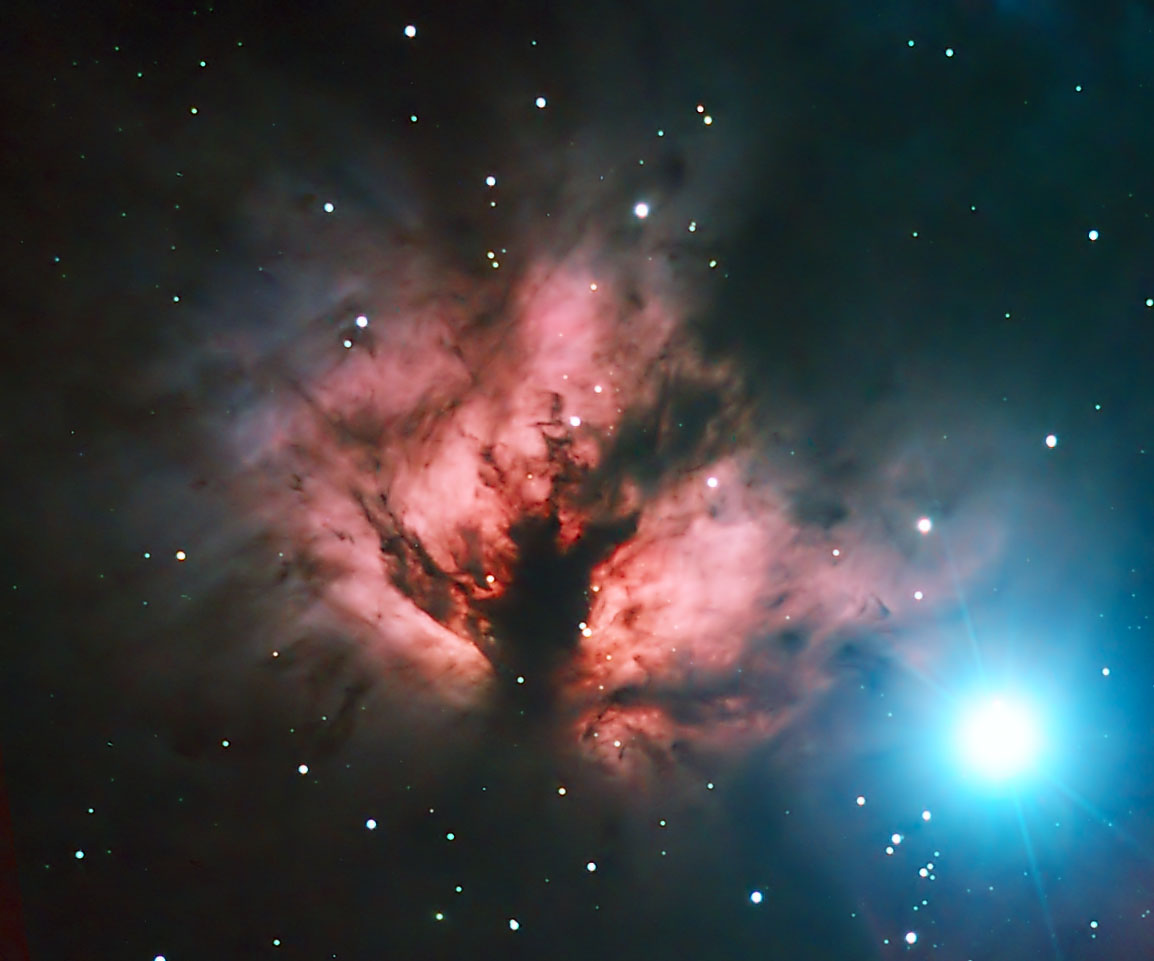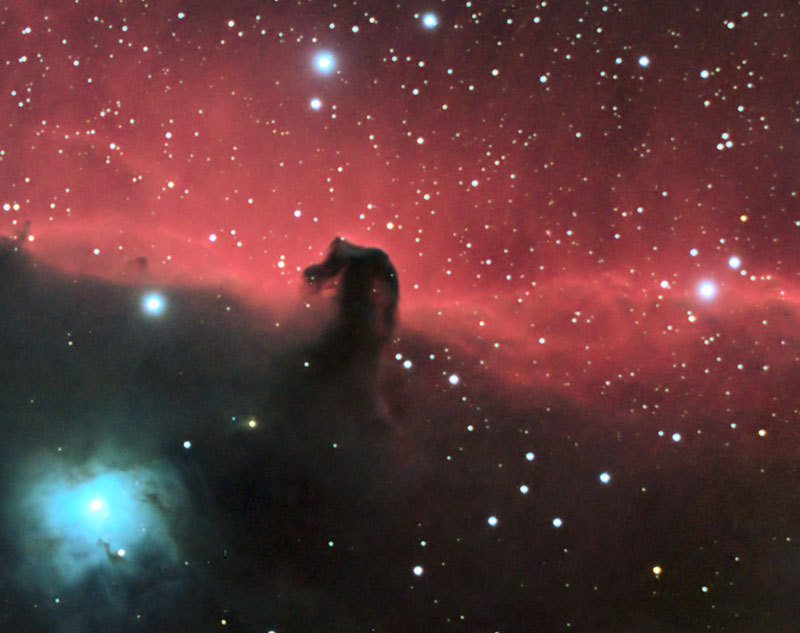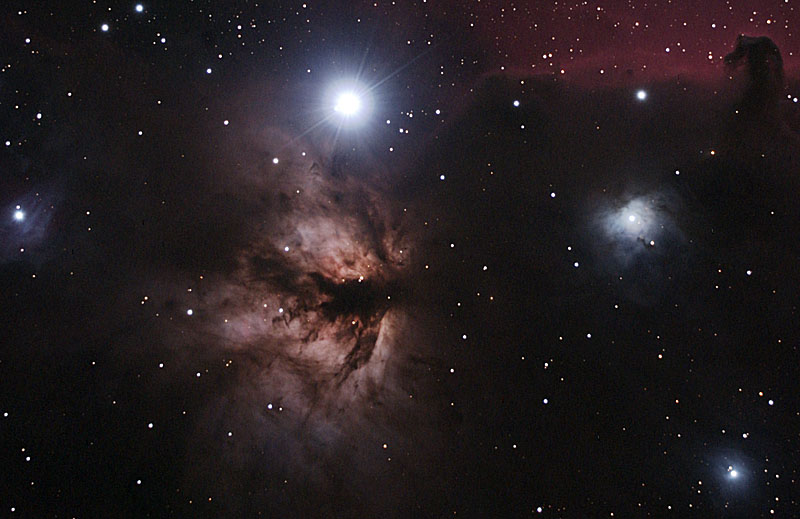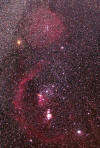
See the Horsehead Nebula narrowband here


This Flame nebula (NGC 2024) image, represents about 2 hours "normal" exposure, plus 4 hours of H-Alpha (deep red) from the backyard blended in. This area is rich in hydrogen alpha wavelength emissions. Radiation is causing clouds of hydrogen gas fluoresce (glow). This technique results in some extra wild aqua/cyan coloring in some of the stars, as you can tell. The Flame Nebula is below Alnitak, which is the left-most star in Orion's famous 3 star belt.

Horsehead nebula picture constructed same as flame, above. Designated Barnard 33 (B33).
What am I looking at? A dark nebula. Nebulae consist of huge clouds of gas and dust particles involved with star formation. Nearby stars radiate ultraviolet light, which causes the gas to fluoresce. Hydrogen gas glows red, and other combinations of gasses and dust glows with other colors. Light reflecting and diffusing with dust can produce reflection nebula (blue) nebula.
The Horsehead Nebula is the most famous example of a dark (or absorption) nebula. Dark nebulae consist of black clouds of dust that obscure brighter objects behind them.
More Info:
The Horsehead Nebula, a part of the optical nebula IC434 and also known as Barnard 33, was first recorded in 1888 on a photographic plate taken at the Harvard College Observatory. Its coincidental appearance as the profile of a horse's head and neck has led to its becoming one of the most familiar astronomical objects. [...]
The marked change in the density of stars visible on either side indicates that the strip of glowing hydrogen marks the edge of a substantial dark cloud. [...]
The `streamers' visible in the brighter region appear to be due to a magnetic field which leaves the Horsehead cloud approximately radially, having been entrained by outflowing matter. Small red spots in the base of the Horsehead betray the presence of hidden protostars, and red streaks near the yellowish nebula surrounding V615 Orionis (bottom left) are Herbig-Haro objects, which are jets of material ejected from protostars. The Horsehead is a fascinating, active, and complex neighborhood.
Location: 05 38 27 -02 29 (1950.0), constellation of Orion.
Distance: about 1600 light-years.
Credit: Nigel Sharp/NOAO. Image \copyright AURA Inc./NOAO.
Credit for above: N.A.Sharp/NOAO/AURA/NSF (for details see Conditions of Use)
DSLR Image below: 4 hours total exposure, Astronomik 13nm Hydrogen Alpha filter, ISO 1600. Canon EOS 20Da (unmodified), Takahashi TOA 130 (a 5" APO refractor) with reducer, and Astro-Physics AP 900GTO mount. This image is beginning to show a feature I call "sheeting" or "steaming". ("Streamers" appears to be the accepted term.) You can also see it's still fairly noisy (grainy). Still more exposure is needed to smooth that out. My 20Da camera 's "stock" IR filter blocks out more H-alpha light than in other, specially modified DSLRS. (See updated QHY8 image above.)


This version is processed to best show details in the Flame Nebula, which is the large object middle-left in this image. Posted 12/28/2005. It is a combination of 9 exposures of 4 minutes each . Image info: Takahashi TOA 130 (a 5" APO refractor) and Canon EOS D20a. See more colorful results here (large images).


(Discussion of old film version in thumbnail above) This shows a number of nebulae in the area of Orion's belt. Alnitak, the brightest star in the frame, is the left-most star in Orion's belt. You can see a variety of nebula colors in this shot. Nebulae consist of huge clouds of gas and dust particles involved with star formation. Nearby stars radiate ultraviolet light, which causes the gas to fluoresce. Hydrogen gas glows red, and other combinations of gasses and dust glows with other colors. Light reflecting and diffusing with dust can produce reflection nebula (blue) nebula.
The Horsehead Nebula is the most famous example of a dark (or absorption) nebula. Dark nebulae consist of black clouds of dust that obscure brighter objects behind them. The Flame Nebula is below Alnitak.

Orion: Widefield with Links to Objects
You can compare with: Orion Area, 300mm, which has links to other Orion-area pictures. Also, check out the Nikon D100 DSLR image: D100 Horsehead and Flame Nebula in Orion
Film Photo above, thumbnail, by Dick Locke
Wimberly, TX, and Brazos Bend State Park, TX
January 1, 2003 and December 27, 2002
Two exposures of 53 and 55 minutes
Combined with Registar
Tak FS-102 prime focus with reducer at 610mm focal length, f5.9
SBIG STV autoguider using Celestron ST-80 guidescope
Losmandy GM-11 mount
Kodak LE 400 film, OM1n camera
Negative Scan, Nikon Coolscan IV ED, Processed in Photoshop*
Astronomy Pictures: Dick Locke's Astrophoto Gateway page....
Copyright © 2002-2009 Dick Locke. All Rights Reserved.
Contact and Image Use Information
*Photoshop talk on the film image: Both shots were pretty good. Set the black point to 20-20-25 as I recall, by selecting an area towards the edge of the screen. I did the normal contrast stretching with curves. I believe I increased the color saturation a bit (say 15 or 20). I also believe I did a little select color range followed by Gaussian blurring to get rid of some of the film grain in the darker areas. It looks like I did a bit of red and green level manipulation in curves. One small trick is that you can select the point on the curve corresponding to where the eyedropper is by clicking on it, and you can select a color channel & do the same thing. So you can select the red channel (in curves here) and a point in the nebula, and raise that level a tad. Another trick is that you can manipulate the curves in small amounts using the arrow key...
So, nothing real fancy. Starting with two good shots gets you 80% of where you need to be.